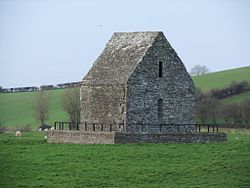County Louth
County Louth (Irish: Contae Lú)[2][3] is a county on the east coast of Ireland, on the border with Northern Ireland.
|
Irish: Contae Lú | |
|---|---|
|
| |
 | |
| Coordinates: 53°50′N 6°30′W / 53.833°N 6.500°WCoordinates: 53°50′N 6°30′W / 53.833°N 6.500°W | |
| Country | Ireland |
| Province | Leinster |
| Dáil Éireann | Louth |
| EU Parliament | East |
| County seat | Dundalk |
| Government | |
| • Type | County Council |
| Area | |
| • Total | 826 km2 (319 sq mi) |
| • Rank | 32nd |
| Population (2011) | 122,808 |
| • Rank | 18th [1] |
| Car plates | LH |
| Website | www |

The county town is Dundalk, which is also the second largest town in Louth. Most people that live in Louth live in the two biggest towns, Dundalk and Drogheda. The 2006 Census[1] showed that Dundalk and Drogheda as not only the largest towns in the Louth, but also the second and third largest towns in Ireland.
Louth is nicknamed "the Wee County" because it is the smallest county[4] in Ireland ("wee" means small).[5]
Where the name comes from
The old Irish name of the county Lughbhaidh comes from the place where people worshipped the Celtic god Lugh whose festival was celebrated at Lúnasa.
The name is now spelled as An Lú. This is just the modern way of spelling Lughbhaidh. 'Lú' means 'small' in Irish, but this is not where the name comes from.
History
The history of Louth goes back a long time. Before people wrote down histories and dates, a famous Irish story is supposed to have happened in Louth. It is called the Táin Bó Cúailnge. In this story, a famous warrior called Cúchulainn fights a whole army by himself to protect a brown bull from being stolen.
There are some old monasteries in the county including Monasterboice and Mellifont Abbey
In the fourteenth century the Scottish army of Edward Bruce lost the Battle of Faughart near Dundalk. Edward was killed in the battle. Oliver Cromwell attacked Drogheda in 1649 killing the Royalist garrison (Siege of Drogheda).
Places in County Louth
Towns
County Louth Media
Winter snow at Slieve Foy
Summer meadow in Johnstown
St. Mochta's House, a 1,000-year-old oratory in Louth village
Slive Foy and King John's Castle
References
- ↑ 1.0 1.1 Central Statistics Office Census 2006 Reports. Central Statistics Office Ireland (April 2007).
- ↑ Louth - Britannica Online Encyclopedia
- ↑ "Location Result". Archived from the original on 2007-12-18. Retrieved 2008-09-30.
- ↑ "North West Passage : : Brochures : Ireland Travel Tourism Tour Irlande Irlanda Irland Donegal Dublin Dungannon Armagh Omagh Strabane Louth Meath Monaghan". Archived from the original on 2018-03-21. Retrieved 2008-09-30.
- ↑ Louth Ireland / Ireland Louth / County louth ireland / Hotel Louth, Restaurant Louth, Hotels Ireland, Travel Guide County Louth Ireland, Louth Attractions
Other websites
- Omeath Online - Official Site of Omeath, Co. Louth Archived 2022-03-16 at the Wayback Machine
- Carlingford Online - Carlingford Local and Tourist Site Archived 2014-07-01 at the Wayback Machine
- Dunleer Parish
- Louth Local Authorities
- Drogheda Tourism - Official Site of the Drogheda Tourist Office
| Wikimedia Commons has media related to Lua error in Module:Commons_link at line 62: attempt to index field 'wikibase' (a nil value).. |









